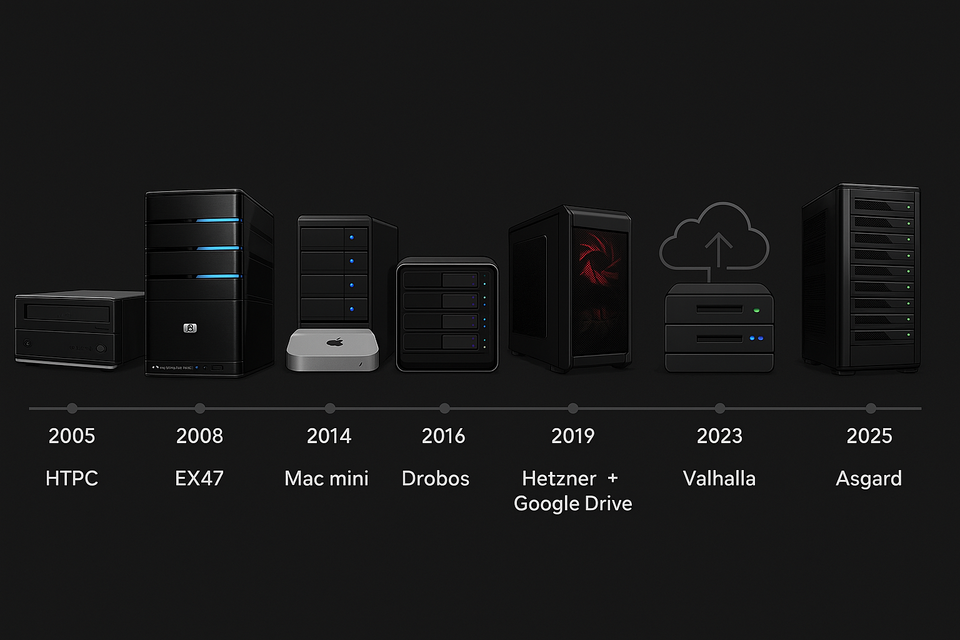Two Decades of Home Server Hell: A Story of Bytes, Broken Dreams, and Bad Decisions

Some people pick up normal hobbies like woodworking or running. Not me. I decided to spend the last 20 years turning my living room, study, basement, and spare mental capacity into a constantly mutating digital Frankenstein monster. What started with a janky HTPC and a dream has evolved into a fully automated, Unraid-powered, Plex-blasting, cloud-dodging, fireproof, sanity-resistant fortress of solitude. Welcome to the chronicles of my insanity—the Rick Home Server Journey.

🧱 2005 – SilverStone HTPC: Where the Madness Began
Ah yes, the SilverStone Lascala LC20M. A horizontal HTPC case that looked like a DVD player but weighed more than your average car battery. I stuffed it with... something. No idea what hardware. Could’ve been powered by a squirrel on a treadmill and a Pentium 4 running hot enough to warm soup.
This beautiful monster ran Windows 7, because Vista was a meme and XP was tired. For media? I used Newsleecher to manually download from Usenet, manually repair corrupted files with PAR2, manually unpack them with WinRAR, manually rename them, and manually move them into folders like some kind of file-sorting medieval peasant.
Playback was via VLC, of course, using a wireless keyboard with a tiny joystick nub for a mouse that was only visible from the couch if the stars aligned and the gods of DPI smiled upon me. That joystick was so unresponsive I developed a squint that still twitches when I see the VLC cone icon.
This was the stone age of home media. There was no Plex. No Sonarr. No Radarr. Just raw willpower and badly named AVI files.

📡 2008 – HP MediaSmart EX470: The Headless Hellspawn
From the HTPC, I graduated to the HP MediaSmart EX470, a sexy little black box that promised ease and elegance and delivered neither. It ran Windows Home Server, had 512MB of RAM, and no video output—just vibes and your own tears.
I ran XBMC clients in multiple rooms. Each had its own metadata, its own watched status, and its own plans to betray me. I couldn’t even resume a movie in another room. Starting a movie in the living room and continuing it in the bedroom was a fantasy.
Networking was wireless G, sometimes N if I was lucky, which meant 1080p content was basically a slideshow. 720p was the max unless you enjoyed buffering as a personality trait. One client was a modded original Xbox. Yes. With a 10/100 Ethernet port and an attitude. Other clients were tiny Acer net-turds and early NUCs that ran so hot they could double as pancake griddles.

🧯 2010 – Acer Aspire H342: The Slightly Less Shitty Upgrade
This was a box that whispered, "I’ll help," and then immediately set your expectations on fire. Still Windows Home Server, still janky, but now with a glorious 2GB of DDR2 RAM—because I know how to treat myself.
The H342 also had no video out, because Acer believed troubleshooting was for cowards. So I jammed a PCI video card into it like I was disarming a bomb with kitchen tongs.
Same XBMC clients. Same decentralized chaos. Still zero automation. But it booted faster. Sometimes. If you prayed.

🍏 2014 – Mac Mini + Drobo: Elegant Suffering
Before I dove off the deep end into Hackintosh hell, I took a detour through Apple land with the original Mac Mini. I had Drobo 5D and 5Ns hooked up via USB and ran Plex, Sonarr, Radarr, and SABnzbd directly on macOS.
It was a slick setup—quiet, simple, almost refined. But the USB port situation made expansion about as feasible as running a LAN party on a TI-83. That Mac Mini choked the second I asked it to do more than stream two things at once. And the moment I wanted to do something advanced, macOS would gently pat me on the head and say, "No, darling. That’s a grown-up task."
Still, it was the first setup that felt like a real media server. Until it didn't.

🔧 2016 – Milano ("Slacker Hackintosh"): The Peak of Reckless Genius
I built Milano to replace the Mac Mini. It was born from the unholy union of ambition and stupidity—a Hackintosh that somehow worked and didn't immediately catch fire. Originally named Slacker Hackintosh, it ran macOS with:
- Intel i7-6700K
- 32GB DDR4 RAM
- Multiple Drobo units strapped on like performance-draining tumors
Everything ran natively on macOS. No Docker. No containers. Just raw applications like it was the Wild West of software management. It was powerful, sure, but I lived in fear of macOS updates. One wrong update and I’d wake up to find my Plex server had become a spinning beach ball of death.

🛰️ 2019 – Hetzner + Google Team Drive: Cloud Criminal Mastermind
One day, I found a script online. That script led to a Hetzner VPS and a Google Team Drive. Then came Rclone. And from that unholy trinity, a dark era was born.
I mounted the Team Drive to the VPS and started slinging data. Not 4K HDR, no sir—just regular, ol’ 1080p files. But a LOT of them. Like, a lot. The Google gods looked down and said:
“Why is this mortal storing 70 terabytes of encrypted data from a shared team drive for only $10 a month?”
And I said: "Because you let me."
They revoked my joy shortly thereafter, fun while it lasted!

⚔️ 2023 – Valhalla: My First True Fortress
When the cloud collapsed under the weight of my ambition, I shucked every last drive from those Drobo coffins and assembled something worthy of legend: Valhalla.
Built inside a sleek tower, Valhalla is where my home media efforts finally came of age. Powered by an Intel Core i5-13500, packed with 128GB of DDR5 RAM, and cooled like a goddamn spaceship, Valhalla doesn't just store data—it owns it.
This beast runs:
- Plex
- Radarr
- Sonarr
- SABnzbd
- Overseerr
- Tautulli
- Home Assistant
- Dashy dashboards
- Virtual machines (including Windows 10)
- Databases, backup automations, and diagnostic monitoring tools
All running on Unraid OS Pro, flawlessly orchestrated through Docker containers like a maestro conducting a data symphony. It’s got a full suite of NVMe caches, whisper-quiet fans, and 160TB of usable space with dual disk protection parity spread across 16 drives.
Valhalla is more than a server. It’s a damn lifestyle. It hums gently in the background of my life, handling everything from media downloads to smart home automations to quietly judging me when I rewatch the same episode of Game of Thrones for the third time.

🔨 2025 – Asgard: The Backup Beast and Upgrade Supreme
Born from the hard-earned lessons of building Valhalla, Asgard is not just a backup server. It’s a full-blown upgrade in every way.
This time, I went all in:
- Intel Core Ultra 5 235 CPU
- 64GB of DDR5 RAM (because I learned 128gigs was overkill)
- Three cache pools (Primary, Secondary, and Tertiary—because redundancy needs redundancy)
- 10 active data drives for a combined 236TB of usable space
This thing is a tank—the kind of server you build when you’ve been burned by Drobo, betrayed by Google, and broken by macOS updates. It’s designed not only to mirror Valhalla’s capabilities but to outpace them when needed. Every bit of it—from the efficient airflow to the tiered cache strategy—was informed by blood, sweat, and a stack of support tickets.
Asgard doesn’t glow. It doesn’t brag. It doesn’t break. It just sits there in the dark, cool and silent, holding bits in a sea of RAID.
It’s not the sidekick. It’s the failsafe overlord.
💬 Final Thoughts: Twenty Years of Beautiful Stupidity
This journey started with a VLC playlist and a joystick mouse. It passed through WHS purgatory, Drobo dependency, macOS mania, and a Google Drive usage policy violation so severe it probably made a sysadmin spill their coffee.
And now?
Now I’ve got a battle-tested Unraid stack with Docker, automation, automated backups, and an entire fleet of servers named after Norse mythology. I don’t just store data. I curate it.
If you’re new to this world, let me give you some advice:
- You will lose data.
- You will scream at Plex.
- You will install something dumb at 2 a.m. and break your entire array.
- But you’ll learn. And one day, you’ll wake up in your man cave, surrounded by server hums, blinking lights, and your own ridiculous timeline of evolution, and say:
“I didn’t just build a server. I built a legacy. And probably an electrical hazard.”
